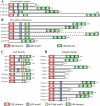ALP/Enigma PDZ-LIM domain proteins in the heart
- PMID: 20042479
- PMCID: PMC2905065
- DOI: 10.1093/jmcb/mjp038
ALP/Enigma PDZ-LIM domain proteins in the heart
Abstract
Actinin-associated LIM protein (ALP) and Enigma are two subfamilies of Postsynaptic density 95, discs large and zonula occludens-1 (PDZ)-Lin-11, Isl1 and Mec-3 (LIM) domain containing proteins. ALP family members have one PDZ and one LIM domain, whereas Enigma proteins contain one PDZ and three LIM domains. Four ALP and three Enigma proteins have been identified in mammals, each having multiple splice variants and unique expression patterns. Functionally, these proteins bind through their PDZ domains to alpha-actinin and bind through their LIM domains or other internal protein interaction domains to other proteins, including signaling molecules. ALP and Enigma proteins have been implicated in cardiac and skeletal muscle structure, function and disease, neuronal function, bipolar disorder, tumor growth, platelet and epithelial cell motility and bone formation. This review will focus on recent advances in the biological roles of ALP/Enigma PDZ-LIM domain proteins in cardiac muscle and provide insights into mechanisms by which mutations in these proteins are related to human cardiac disease.
Figures

Similar articles
-
ENH, containing PDZ and LIM domains, heart/skeletal muscle-specific protein, associates with cytoskeletal proteins through the PDZ domain.Biochem Biophys Res Commun. 2000 Jun 7;272(2):505-12. doi: 10.1006/bbrc.2000.2787. Biochem Biophys Res Commun. 2000. PMID: 10833443
-
Actinin-associated LIM protein-deficient mice maintain normal development and structure of skeletal muscle.Mol Cell Biol. 2001 Mar;21(5):1682-7. doi: 10.1128/MCB.21.5.1682-1687.2001. Mol Cell Biol. 2001. PMID: 11238905 Free PMC article.
-
PDZ and LIM domain-encoding genes: molecular interactions and their role in development.ScientificWorldJournal. 2007 Sep 1;7:1470-92. doi: 10.1100/tsw.2007.232. ScientificWorldJournal. 2007. PMID: 17767364 Free PMC article. Review.
-
Characterization of the interaction between Actinin-Associated LIM Protein (ALP) and the rod domain of alpha-actinin.BMC Cell Biol. 2009 Mar 27;10:22. doi: 10.1186/1471-2121-10-22. BMC Cell Biol. 2009. PMID: 19327143 Free PMC article.
-
The PDLIM family of actin-associated proteins and their emerging role in membrane trafficking.Biochem Soc Trans. 2023 Dec 20;51(6):2005-2016. doi: 10.1042/BST20220804. Biochem Soc Trans. 2023. PMID: 38095060 Free PMC article. Review.
Cited by
-
Zasp52, a Core Z-disc Protein in Drosophila Indirect Flight Muscles, Interacts with α-Actinin via an Extended PDZ Domain.PLoS Genet. 2016 Oct 26;12(10):e1006400. doi: 10.1371/journal.pgen.1006400. eCollection 2016 Oct. PLoS Genet. 2016. PMID: 27783625 Free PMC article.
-
Myofibril diameter is set by a finely tuned mechanism of protein oligomerization in Drosophila.Elife. 2019 Nov 20;8:e50496. doi: 10.7554/eLife.50496. Elife. 2019. PMID: 31746737 Free PMC article.
-
Actin cytoskeleton remodeling by the alternatively spliced isoform of PDLIM4/RIL protein.J Biol Chem. 2011 Jul 29;286(30):26849-59. doi: 10.1074/jbc.M111.241554. Epub 2011 Jun 2. J Biol Chem. 2011. PMID: 21636573 Free PMC article.
-
Diseases caused by mutations in Nav1.5 interacting proteins.Card Electrophysiol Clin. 2014 Dec 1;6(4):797-809. doi: 10.1016/j.ccep.2014.08.007. Card Electrophysiol Clin. 2014. PMID: 25395996 Free PMC article.
-
Z-band alternatively spliced PDZ motif protein (ZASP) is the major O-linked β-N-acetylglucosamine-substituted protein in human heart myofibrils.J Biol Chem. 2013 Feb 15;288(7):4891-8. doi: 10.1074/jbc.M112.410316. Epub 2012 Dec 27. J Biol Chem. 2013. PMID: 23271734 Free PMC article.
References
-
- Andersen O., Ostbye T.K., Gabestad I., Nielsen C., Bardal T., Galloway T.F. Molecular characterization of a PDZ–LIM protein in Atlantic salmon (Salmo salar): a fish ortholog of the alpha-actinin-associated LIM-protein (ALP) J. Muscle Res. Cell Motil. 2004;25:61–68. - PubMed
-
- Arimura T., Hayashi T., Terada H., Lee S.Y., Zhou Q., Takahashi M., Ueda K., Nouchi T., Hohda S., Shibutani M., et al. A Cypher/ZASP mutation associated with dilated cardiomyopathy alters the binding affinity to protein kinase C. J. Biol. Chem. 2004;279:6746–6752. - PubMed
-
- Arimura T., Inagaki N., Hayashi T., Shichi D., Sato A., Hinohara K., Vatta M., Towbin J.A., Chikamori T., Yamashina A., et al. Impaired binding of ZASP/Cypher with phosphoglucomutase 1 is associated with dilated cardiomyopathy. Cardiovasc. Res. 2009;83:80–88. - PubMed
-
- Au Y., Atkinson R.A., Guerrini R., Kelly G., Joseph C., Martin S.R., Muskett F.W., Pallavicini A., Faulkner G., Pastore A. Solution structure of ZASP PDZ domain; implications for sarcomere ultrastructure and enigma family redundancy. Structure. 2004;12:611–622. - PubMed
-
- Barres R., Gonzalez T., Le Marchand-Brustel Y., Tanti J.F. The interaction between the adaptor protein APS and Enigma is involved in actin organisation. Exp. Cell Res. 2005;308:334–344. - PubMed
Publication types
MeSH terms
Substances
Grants and funding
LinkOut - more resources
Full Text Sources
Miscellaneous

